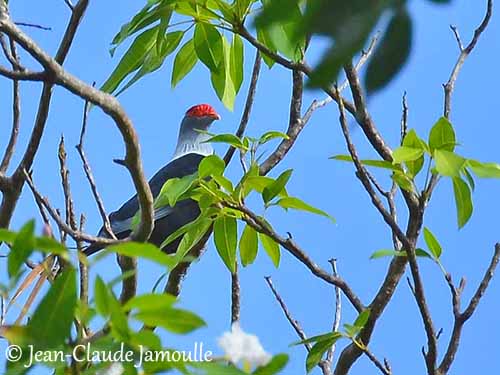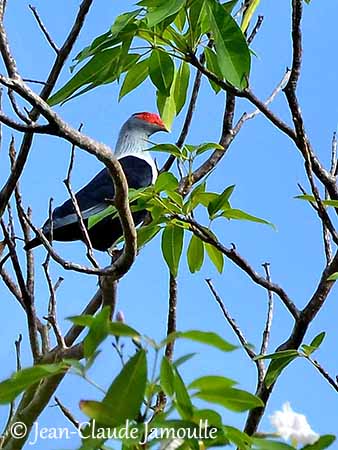
Fr: Founingo rougecap
All: Warzenfruchttaube
Esp: Paloma Azul de Seychelles
Ita: Colomba verrucosa
Nd: Seychellen-Blauwe Duif
Sd: Seychellblåduva
Photographer:
Jean-Claude Jamoulle
A la rencontre des Oiseaux
Text by Nicole Bouglouan
Sources:
HANDBOOK OF THE BIRDS OF THE WORLD vol 4 by Josep del Hoyo-Andrew Elliott-Jordi Sargatal - Lynx Edicions - ISBN: 8487334229
PIGEONS AND DOVES by David Gibbs, Eustace Barnes and John Cox - Pica Press Sussex - ISBN: 1873403607
BirdLife International (BirdLife International)
Aqua-Firma – Water – Wilderness – Wildlife
Seychelles Blue-Pigeon
Alectroenas pulcherrima
Columbiformes Order – Columbidae Family
INTRODUCTION:
The Seychelles Blue-Pigeon is a resident species endemic to the Seychelles Archipelago. Unlike numerous island birds, this species is not currently threatened, in spite of recent declines.
DESCRIPTION OF THE BIRD:
Biometrics:
Length: 24-25 cm
Weight: 160-165 g
The adult has blackish-blue body plumage, including wings and tail. However, the flight feathers show silvery-grey tinge.
There is a strong contrast between the dark body and the pale grey throat, head sides and nape, turning silvery grey on neck and breast. The hind crown is dark reddish.
Head and neck feathers are stiffened, elongated and glossy. They can be raised during displays, giving a ruffled appearance.
The eyes are yellowish-orange, surrounded by bare, red eyering. The orbital skin extends to lores, forehead and forecrown, forming a patch of bare, bright red skin with wattles.
The bill is reddish at base and horn-yellow at tip. Legs and feet are greyish, with partially feathered tarsi.

The female is similar but duller. She may have some pale-edged feathers on body. She has greyer head and neck.
The juvenile is distinctly different from adult. It has bronzy-green plumage with conspicuous yellowish edgings, whereas head and neck are dull greenish-grey.
RANGE:
The Seychelles Blue-Pigeon is found in the Seychelles Archipelago, and it occurs on Praslin, Felicité, Silhouette, frigate, Marianne and Mahé Islands.
HABITAT:
The Seychelles Blue-Pigeon frequents wooded habitats and occurs in remaining stands of humid montane forests. This species is able to adapt to fragmentation and degradation of its habitat. It visits fruiting trees in secondary growths and cultivated areas.
CALLS AND SONGS: SOUNDS BY XENO-CANTO
The Seychelles Blue-Pigeon produces a deep, hoarse cooing. The song is a series of harsh, accelerating notes which may trail off in volume at the end. But usually, this pigeon is mainly silent.
BEHAVIOUR IN THE WILD:
The Seychelles Blue-Pigeon is usually seen in pairs, but they often gather at fruiting trees all the year. They can be seen in small groups outside the breeding season. They are arboreal, and are rarely seen on the ground.
The Seychelles Blue-Pigeon feeds on numerous fruits and berries (wild Psidium), cinnamon berries and nuts of Calophyllum tacamahaca, an endemic species to Mascarene Islands.
During the breeding season, the males often chase each other in fast flight displays. They also perform stunning displays such as ritual fighting. They can become very aggressive during this period.
The Seychelles Blue-Pigeon is resident and sedentary in its range, only moving for feeding.

REPRODUCTION OF THIS SPECIES:
The breeding season is probably extended.
Like all Columbidae, they build a flimsy platform with twigs and rootlets, usually up to 6 metres above the ground. The nest is placed in tree or bush, in a fork or on horizontal branch, and always well concealed among the vegetation. The nest is built by the female.
She lays 1-2 eggs. The laying appears related to abundance of seeds. Both sexes incubate during 28 days. The chicks are fed by their parents and fledge two weeks after hatching.
PROTECTION / THREATS / STATUS:
The Seychelles Blue-Pigeon has restricted range, but it occurs on several islands. In spite of recent decline due to reduced fruit production and hunting pressure, the species is not currently threatened.